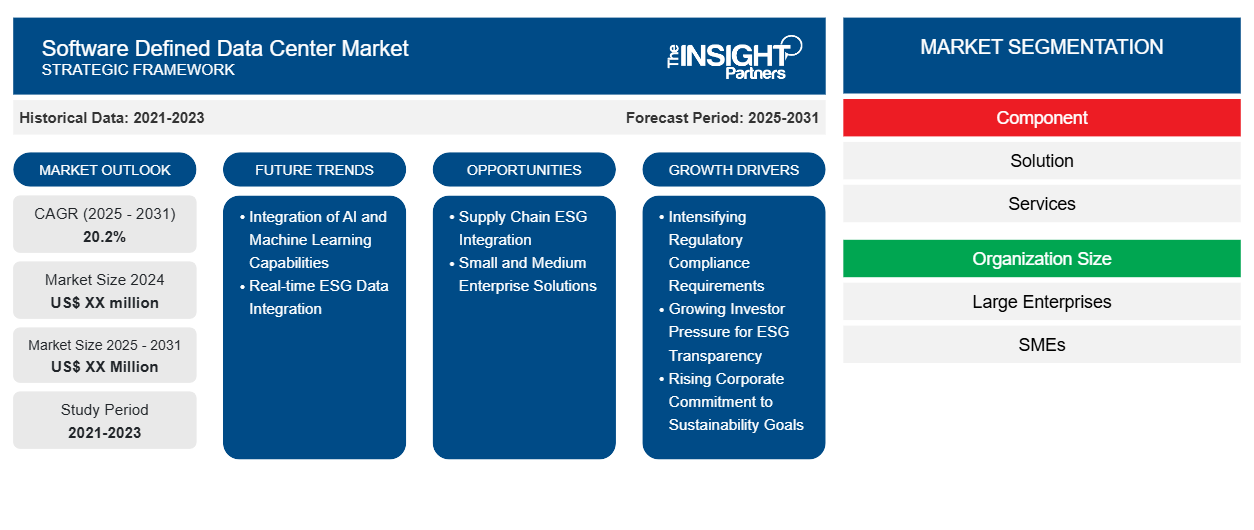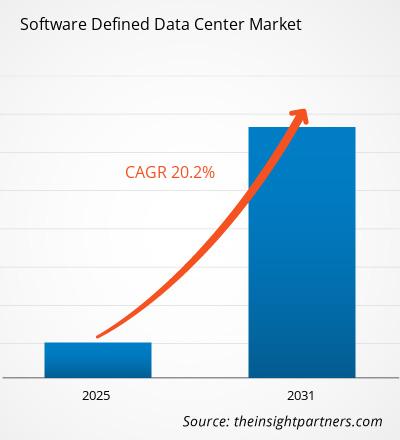Si prevede che il mercato dei data center definiti dal software registrerà un CAGR del 20,2% dal 2025 al 2031, con una dimensione del mercato in espansione da XX milioni di dollari nel 2024 a XX milioni di dollari entro il 2031.
Il report è segmentato per Componente (Soluzione, Servizi); Dimensione dell'organizzazione (Grandi Imprese, PMI); Utenti finali (Imprese, Fornitori di servizi di telecomunicazione, Fornitori di servizi cloud, Fornitori di servizi gestiti). L'analisi globale è ulteriormente suddivisa a livello regionale e per i principali Paesi. Il report fornisce il valore in USD per l'analisi e i segmenti sopra indicati.
Scopo del rapporto
Il rapporto "Software Defined Data Center Market" di The Insight Partners mira a descrivere il panorama attuale e la crescita futura, i principali fattori trainanti, le sfide e le opportunità. Questo fornirà spunti di riflessione a diversi stakeholder aziendali, tra cui:
- Fornitori/produttori di tecnologia: per comprendere le dinamiche di mercato in evoluzione e conoscere le potenziali opportunità di crescita, consentendo loro di prendere decisioni strategiche informate.
- Investitori: per condurre un'analisi completa delle tendenze in merito al tasso di crescita del mercato, alle proiezioni finanziarie del mercato e alle opportunità esistenti lungo la catena del valore.
- Enti di regolamentazione: regolamentano le politiche e le attività di controllo sul mercato con l'obiettivo di ridurre al minimo gli abusi, preservare la fiducia degli investitori e sostenere l'integrità e la stabilità del mercato.
Segmentazione del mercato dei data center definiti dal software
Componente
- Soluzione
- Servizi
Dimensione dell'organizzazione
- Grandi imprese
- PMI
Utenti finali
- Imprese
- Fornitori di servizi di telecomunicazione
- Fornitori di servizi cloud
- Fornitori di servizi gestiti
Geografia
- America del Nord
- Europa
- Asia Pacifico
- Medio Oriente e Africa
- America meridionale e centrale
Riceverai la personalizzazione gratuita di qualsiasi report, incluse parti di questo report, analisi a livello nazionale, pacchetto dati Excel e potrai usufruire di fantastiche offerte e sconti per start-up e università.
Mercato dei data center definiti dal software: approfondimenti strategici

- Scopri le principali tendenze di mercato di questo rapporto.Questo campione GRATUITO includerà analisi dei dati, che spaziano dalle tendenze di mercato alle stime e alle previsioni.
Fattori di crescita del mercato dei data center definiti dal software
- Intensificazione dei requisiti di conformità normativa: il panorama normativo globale per la rendicontazione ESG sta diventando sempre più complesso e stringente. Nuove normative come la CSRD dell'UE, le norme sulla divulgazione climatica della SEC e vari mandati nazionali stanno costringendo le organizzazioni ad adottare soluzioni di rendicontazione sofisticate. Il software di rendicontazione ESG fornisce controlli di conformità automatizzati, framework standardizzati e documentazione pronta per la revisione per soddisfare questi requisiti in continua evoluzione. La capacità del software di monitorare più standard di rendicontazione contemporaneamente, garantendo al contempo l'accuratezza e la coerenza dei dati nelle diverse giurisdizioni, lo rende essenziale per le organizzazioni che operano in più contesti normativi.
- Crescente pressione degli investitori per la trasparenza ESG: gli investitori istituzionali e gli stakeholder richiedono maggiore trasparenza e granularità nelle informative ESG. Le organizzazioni necessitano di soluzioni software affidabili per raccogliere, verificare e rendicontare le metriche ESG che soddisfino i requisiti di due diligence degli investitori. Il software consente alle aziende di fornire dati dettagliati sulle performance di sostenibilità, valutazioni di impatto e monitoraggio dei progressi rispetto agli obiettivi ESG. Questa capacità è particolarmente cruciale per le società quotate e per coloro che cercano finanziamenti sostenibili, poiché gli investitori integrano sempre più le performance ESG nelle loro decisioni di investimento.
- Crescente impegno aziendale verso gli obiettivi di sostenibilità: le organizzazioni si stanno ponendo obiettivi di sostenibilità ambiziosi e necessitano di strumenti sofisticati per monitorare e rendicontare i propri progressi. I software di reporting ESG forniscono un monitoraggio in tempo reale degli impatti ambientali, delle iniziative sociali e delle pratiche di governance. Queste piattaforme consentono alle aziende di misurare le emissioni di carbonio, monitorare il consumo di risorse, monitorare la sostenibilità della catena di fornitura e valutare le metriche di impatto sociale. Le capacità analitiche del software aiutano le organizzazioni a identificare le aree di miglioramento e a dimostrare progressi tangibili verso i propri impegni di sostenibilità.
Tendenze future del mercato dei data center definiti dal software
- Integrazione di funzionalità di intelligenza artificiale e apprendimento automatico: le piattaforme di reporting ESG stanno integrando sempre più l'intelligenza artificiale e l'apprendimento automatico per migliorare le capacità di raccolta, analisi e reporting dei dati. Queste tecnologie consentono l'estrazione automatizzata dei dati da diverse fonti, il rilevamento di anomalie nelle metriche ESG e l'analisi predittiva per le performance di sostenibilità. Le funzionalità basate sull'intelligenza artificiale aiutano le organizzazioni a identificare tendenze, prevedere impatti e generare report di sostenibilità più accurati, riducendo al contempo l'impegno manuale e i potenziali errori umani.
- Integrazione dei dati ESG in tempo reale: il mercato si sta orientando verso funzionalità di raccolta e reporting dei dati ESG in tempo reale. Le organizzazioni richiedono piattaforme in grado di monitorare e aggiornare costantemente le metriche ESG, anziché affidarsi ad aggiornamenti manuali periodici. Questa tendenza è guidata dalla necessità di processi decisionali e comunicazioni con gli stakeholder più tempestive in merito alle performance ESG. Il monitoraggio in tempo reale consente l'identificazione immediata dei problemi e una risposta più rapida alle sfide di sostenibilità.
Opportunità di mercato per i data center definiti dal software
- Integrazione ESG nella Supply Chain: esiste un'importante opportunità per i software di reporting ESG di espandersi nel monitoraggio della sostenibilità della supply chain. Le organizzazioni necessitano di strumenti per monitorare e rendicontare le performance ESG dei propri fornitori, garantendo la conformità agli standard di sostenibilità lungo tutta la catena del valore. Le piattaforme software possono facilitare la valutazione dei fornitori, monitorare le certificazioni di sostenibilità e aggregare i dati ESG lungo l'intera rete di fornitura, consentendo una reportistica completa sulle emissioni di Scope 3 e altri impatti indiretti.
- Soluzioni per le Piccole e Medie Imprese: il segmento delle PMI offre una crescente opportunità per soluzioni di reporting ESG semplificate e convenienti. Con l'estensione dei requisiti di reporting sulla sostenibilità alle organizzazioni più piccole, cresce la domanda di piattaforme semplificate che offrano funzionalità di reporting essenziali senza la complessità delle soluzioni di livello aziendale. I fornitori di software possono sviluppare offerte specializzate che aiutino le PMI a soddisfare i requisiti di reporting di base, mantenendo al contempo un rapporto qualità-prezzo accessibile.
Approfondimenti regionali sul mercato dei data center definiti dal software
Le tendenze e i fattori regionali che influenzano il mercato dei Data Center Software-Defined durante il periodo di previsione sono stati ampiamente spiegati dagli analisti di The Insight Partners. Questa sezione illustra anche i segmenti e la distribuzione geografica del mercato dei Data Center Software-Defined in Nord America, Europa, Asia-Pacifico, Medio Oriente e Africa, America Meridionale e Centrale.
Ambito del rapporto di mercato sui data center definiti dal software
| Attributo del report | Dettagli |
|---|---|
| Dimensioni del mercato nel 2024 | XX milioni di dollari USA |
| Dimensioni del mercato entro il 2031 | XX milioni di dollari USA |
| CAGR globale (2025 - 2031) | 20,2% |
| Dati storici | 2021-2023 |
| Periodo di previsione | 2025-2031 |
| Segmenti coperti | Per componente
|
| Regioni e paesi coperti | America del Nord
|
| Leader di mercato e profili aziendali chiave |
|
Densità degli attori del mercato dei data center definiti dal software: comprendere il suo impatto sulle dinamiche aziendali
Il mercato dei Data Center Software-Defined è in rapida crescita, trainato dalla crescente domanda degli utenti finali, dovuta a fattori quali l'evoluzione delle preferenze dei consumatori, i progressi tecnologici e una maggiore consapevolezza dei vantaggi del prodotto. Con l'aumento della domanda, le aziende stanno ampliando la propria offerta, innovando per soddisfare le esigenze dei consumatori e sfruttando le tendenze emergenti, alimentando ulteriormente la crescita del mercato.

- Ottieni una panoramica dei principali attori del mercato dei data center definiti dal software
Punti di forza chiave
- Copertura completa: il rapporto copre in modo esaustivo l'analisi di prodotti, servizi, tipologie e utenti finali del mercato dei data center definiti dal software, fornendo un panorama olistico.
- Analisi degli esperti: il rapporto è redatto sulla base della conoscenza approfondita di esperti e analisti del settore.
- Informazioni aggiornate: il rapporto garantisce la pertinenza aziendale grazie alla copertura delle informazioni più recenti e delle tendenze dei dati.
- Opzioni di personalizzazione: questo report può essere personalizzato per soddisfare le esigenze specifiche del cliente e adattarsi in modo appropriato alle strategie aziendali.
Il rapporto di ricerca sul mercato dei Data Center Software-Defined può quindi contribuire a tracciare un percorso di decodificazione e comprensione dello scenario e delle prospettive di crescita del settore. Sebbene possano esserci alcune valide preoccupazioni, i vantaggi complessivi di questo rapporto tendono a superare gli svantaggi.
- Analisi storica (2 anni), anno base, previsione (7 anni) con CAGR
- Analisi PEST e SWOT
- Valore/volume delle dimensioni del mercato - Globale, Regionale, Nazionale
- Industria e panorama competitivo
- Set di dati Excel
Report recenti
Testimonianze
Motivo dell'acquisto
- Processo decisionale informato
- Comprensione delle dinamiche di mercato
- Analisi competitiva
- Analisi dei clienti
- Previsioni di mercato
- Mitigazione del rischio
- Pianificazione strategica
- Giustificazione degli investimenti
- Identificazione dei mercati emergenti
- Miglioramento delle strategie di marketing
- Aumento dell'efficienza operativa
- Allineamento alle tendenze normative




















 Ottieni un campione gratuito per - Mercato dei data center definiti dal software
Ottieni un campione gratuito per - Mercato dei data center definiti dal software